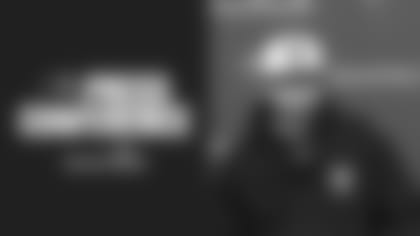In 2010, the Tampa Bay Buccaneers put together one of the most remarkable and entertaining seasons in franchise history. Despite going 3-13 the season before and fielding the youngest roster in the entire league, the Buccaneers won 10 games and only missed the playoffs on a tiebreaker. That seven-win turnaround was the greatest season-to-season improvement in team annals.
With rising young stars peppered all over the depth chart – quarterback Josh Freeman, wide receiver Mike Williams, defensive tackle Gerald McCoy and cornerback Aqib Talib, just to name a few – the Bucs appear to be poised for a long run of success. Expectations will be high heading into the 2011 season, and the excitement will only be magnified by a very intriguing schedule.
That's particularly true of Tampa Bay's eight-game home slate. The Buccaneers play in the NFL's most consistently competitive division, the NFC South, so regular visits from Atlanta, New Orleans and Carolina will provide the usual highlights. The Chicago Bears, coming off an appearance in the NFC Championship Game, will be coming to town, as will another of the league's young teams on the move, the Detroit Lions. The Indianapolis Colts and Houston Texans will bring high-powered offenses to Raymond James Stadium, and the Dallas Cowboys rarely are far from the NFL's center of attention.
The start of the 2011 season is still seven months away, but it's not too early to anticipate the thrills those eight Sundays at Raymond James Stadium will provide next fall. With that in mind, Buccaneers.com is going to run a series of articles focusing on each of the team's 2011 home opponents. We'll look at how each of those teams has fared in recent years, which of their players will be the Buccaneers' main concerns, where the matchups will favor each side, and more.
First up, the Dallas Cowboys.
2010 Results
If the Buccaneers were the most pleasant surprise in the NFL's 2010 standings, then Dallas likely ranked at the other end of that spectrum. Considered strong playoff contenders by most analysts heading into the season, the Cowboys instead lost seven of their first eight and faded quickly from the race.
After the seventh loss, however, a disheartening 45-7 pounding delivered by the eventual-champion Green Bay Packers, the Cowboys dismissed Head Coach Wade Phillips and promoted Jason Garrett to the post. Dallas won its first game under Garrett, a 33-20 shocker on the road against the New York Giants, and went 5-3 down the stretch. Win or lose, they were in every game in the season's second half – each of their three losses was by three points or less and they scored impressive wins over playoff-bound teams like Indianapolis and Philadelphia.
The Cowboys had some not-so-secret designs to become the first Super Bowl team to play on its home field, with big game number XLV scheduled for the gleaming new Dallas Stadium. The 6-10 campaign that unfolded instead was certainly a disappointment, but the 2010 Cowboys might have been closer to the contenders the analysts expected than their record would indicate.
A season-opening 13-7 loss at Washington set the tone, as a potential game-winning touchdown in the fourth quarter was erased by a holding penalty. The Cowboys were tied with the Bears and Tennessee Titans in the fourth period in Weeks Two and Four, respectively, before falling late, and the season took a nastier turn in Week Seven when quarterback Tony Romo was lost to a broken clavicle. Even after righting the ship somewhat under Garrett, the Cowboys couldn't quite shake off the bad mojo. With an upset over New Orleans almost in hand in Week 12, Dallas had the win stunningly stripped away by Saints cornerback Malcolm Jenkins. The Cowboys had taken a 27-23 fourth-quarter lead and were on their way to a clinching score with three minutes to play when Jenkins forced wide receiver Roy Williams to fumble at the Saints' 11 at the end of a 47-yard catch-and-run. Drew Brees then drove the Saints 89 yards for the winning score.
Even with Jon Kitna at the helm for half of the season, the Cowboys fielded one of the league's most potent offenses. Dallas ranked seventh in the NFL in total yards and, more importantly, tied for seventh in points scored. The passing attack was the league's sixth-best, putting up 252.6 yards per game and creating 29 of the team's 46 touchdowns. Jason Witten led all NFL tight ends with 94 catches and 1,002 yards and scored nine times. Rookie wideout Dez Bryant was the only real challenger to the Bucs' Mike Williams as the top newcomer at that position; though he missed the last quarter of the season with a fractured ankle, Bryant caught 45 passes for 561 yards and six touchdowns. He was also a major weapon in the return game, scoring two more times on special teams.
The Cowboys' defense wasn't as effective as expected, however, and with the team ranking 26th against the pass and 31st in points allowed, Dallas was involved in a number of shootouts. The Cowboys gave up 243.2 yards per game through the air and only the Denver Broncos surrendered more points than Dallas' 434. Despite the benefit of having the NFL's sack leader, DeMarcus Ware, invading opposing backfields, the Cowboys' secondary struggled. Cornerbacks Mike Jenkins and Terrence Newman had gone to the Pro Bowl in 2009 and 2008, respectively, but neither seemed to play to that level last year, and new free safety starter Alan Ball, who replaced Ken Hamilton, did not make an enormous impact.
The Cowboys certainly had reason for optimism heading into 2010. They had won 11 games and a strong NFC East the season before, when they were one of just four teams to rank in the top 10 in the NFL in both offense and defense
2011 Priorities
Like many teams in the league, the Cowboys will be expecting a boost from the return of several players from injured reserve, most notably Romo, Bryant and defensive end Marcus Spears. Dallas also owns the ninth pick in the draft and, obviously, has never been shy of the aggressive move in free agency or via trade. Owner Jerry Jones hinted at "significant turnover" near the end of last season, and conceded that the roster as it was pt together wasn't as strong as he thought it was to begin the year. The Cowboys are not likely to sit still over the next seven months; here are some areas they may choose to address.
- Stabilize the offensive line. There wasn't much hand-wringing in Dallas when tackle Flozell Adams was released early last April, in part because the team believed Doug Free would be a strong replacement at left tackle. Free performed well but the right tackle combination of Marc Colombo and Alex Barron (who committed the aforementioned holding penalty in Washington) struggled and the Cowboys might have benefited from the type of depth Adams could have provided. That's the role Adams ended up with in Pittsburgh, as a matter of fact, replacing Willie Colon after Colon's season-ending injury in offseason workouts and starting every game for the Steelers, right up to Super Bowl XLV. Only three of the Cowboys' 24 draft picks in the last four years have been spent on offensive linemen – sixth-rounder Young, who finished the year as the backup to Colombo, and third-rounders Robert Brewster and James Marten, who are no longer with the team.
- Adopt the Garrett/Ryan stamp. How much of the Cowboys' second-half turnaround was a function of Garrett taking over? The answer may be clear in 2011, as he had the interim tag removed immediately after the 2010 season was over. There was obviously a difference in the level of sideline intensity between Phillips and Garrett, and the latter stressed accountability and conducted more rigorous practices. Sometimes lethargic in the first half of the season, the Cowboys seemed to respond to Garrett's approach. The Cowboys also brought in Rob Ryan to serve as Garrett's defensive coordinator, and that should help the head coach get across his message of playing with passion.
- Find more playmakers on defense. DeMarcus Ware may have led the NFL with his 15.5 sacks, but nobody else on the Cowboys' defense recorded more than five QB takedowns. The Cowboys did secure quite a few more turnovers during the second half of the season, with Newman and Gerald Sensabaugh leading the way with five interceptions each, but the team still surrendered a franchise-record number of points. The Cowboys are in transition on defense – Sean Lee took over for the aging Keith Brooking at linebacker and the secondary is likely due for a shakeup – but that might be well-timed with the arrival of Ryan, who will retain the team's 3-4 approach. Most NFL analysts expect the Cowboys to use the ninth overall pick on a defensive difference-maker, perhaps a cornerback or one of the many highly-valued defensive ends.
- Get more out of Felix Jones. Marion Barber had his least productive season yet, rushing for 374 yards and four touchdowns in 13 games. Barber still approaches the game with the sort of passion Garrett admires, but he averaged just 3.3 yards per carry in 2010 and wasn't a factor in the passing game, as he has been in the past. Jones only started seven games but he is clearly the Cowboys' most explosive runner, gaining 800 yards on 165 carries. That's a fine average of 4.3 yards per tote, but that's actually down from the 5.9 he averaged in 2009 and the 8.9 he put up as a rookie in 2008, albeit on just 30 carries. Jones emerged as a threat in the passing game, too, catching 48 passes in 2010, which was more than twice what he recorded in his first two seasons combined. Jones is an electric talent and increasing his load (he averaged fewer than 12 carries per game in 2010) could balance out what should be a very good aerial assault.
Take Five
As much as the Cowboys struggled in 2010, they do have plenty of noteworthy talent on their roster. Here are five players who may cause the Buccaneers the most trouble when Dallas visits Raymond James Stadium next fall.
WR Dez Bryant. The 24th overall pick in the 2010 draft, Bryant appears to be a true double threat. He didn't have enough opportunities to qualify for the league lead in punt return or kickoff return average, but he was good for 14.3 per and two touchdowns in the former and 24.4 per in the latter. He also had the 45 catches and six TDs in the passing game, as mentioned above, including a six-game span just before his injury in which he scored six times and had his first 100-yard outing. With Roy Williams remaining something of an enigma, the opportunity is there for Bryant to join Miles Austin and become one of the more dynamic pairs of starting receivers in the NFL.
LB DeMarcus Ware. There may not have been a more consistent impact player in the entire league over the last five years than Ware. Since he was drafted 11th overall in 2005, Ware has racked up an incredible 80 sacks, or 13.3 per season. He has never missed a game in his career and has hit double digits in sacks in each of the last five years, including 20 in 2008 and the aforementioned 15.5 last year. Ware is no one-trick pony, either. He's strong at the point of attack in the rushing game and can even drop effectively into coverage. When Dallas visits, the Buccaneers' planning on offense will likely begin with the need to account for DeMarcus Ware.
QB Tony Romo. Kitna did a fine job filling in for the Cowboys' injured starter, but there's no doubt that Dallas' offense is more dynamic with their playmaking passer in the lineup. Adept at extending the action and creating big gains out of broken plays, Romo has compiled a passer rating north of 90 in each of his five years as the Cowboys' starter. From 2007-09 he averaged more than 4,000 yards and just under 30 touchdown passes per season despite missing three games in 2008. What's more, he may find himself with his best overall arsenal of weapons since he became the starter in 2006. With Bryant, Austin, Witten and Jones to choose from, Romo should be able to put up big numbers again.
DT Jay Ratliff. The best 3-4 defenses have a nose tackle who can hold the point, occupy double teams and occasionally get upfield for sacks. While he may not be as big as, say, Vince Wilfork in New England or Casey Hampton in Pittsburgh, Ratliff fits the bill. He is very strong for his size (303 pounds) and also active, as evidenced by his 25 sacks in six seasons. Ratliff contributed 3.5 QB takedowns in 2010 after posting 6.0 and 7.5 in the two previous years, respectively. The Bucs' entire line will have their hands full with Ratliff when the Cowboys visit in 2011.
TE Jason Witten. With all the talent the Cowboys possess at wide receiver, it was Witten who was the team's clear leader in receptions in 2010, just as he was in 2009. The ninth-year veteran now has three 90-catch, 1,000-yard seasons in the last four years, only "dipping" to 81 and 952 in 2008. He had been in something of a touchdown drought the previous two years, with just six in 32 games, but he scored nine times in 2010, only one behind the NFL lead for tight ends. Witten's inflated pass-catching totals remain consistent from years to year for two reasons: He's durable, missing just one game in his career so far, and he's a strong blocker in the running game, which keeps him on the field for the majority of his team's snaps.
Franchise History
The Dallas Cowboys have a rich tradition, obviously, including eight Super Bowl appearances and five titles. The Cowboys have also been involved in eight other NFC Championship Games that did not result in Super Bowl trips, including the first two Super Bowls following the 1966 and 1967 seasons. They have not, however, made a conference title game since 1995, at the end of a four-season run that produced three Super Bowl championships. Only the New York Giants have been to more NFC Championship Games, with 18 appearances.
The Cowboys' string of 15 seasons without a trip to the Super Bowl may not seem epic – it's been almost as long for San Francisco and longer for Buffalo, two common Super Bowl teams in the '80s and '90s, and they'll certainly get no sympathy in Detroit or Cleveland – but it is the longest such streak for the franchise.
The Cowboys began play in 1960 as an NFL expansion team, the same season the AFL began play with eight teams of its own, including the Dallas Texans. It was a rough opening year for Dallas, mixing in with 12 established NFL teams, and the Cowboys would have to wait until 1961 for their first win, finishing their inaugural season 0-11-1. The Texans eventually moved to Kansas City in 1963 and became the Chiefs, but the remaining team in Dallas would have to wait until 1966 to post its first winning record. That began a long run of success, however, as Tom Landry's Cowboys won the Eastern Conference in 1966 and 1967 before falling to Vince Lombardi's Green Bay Packers in the NFL Championship Game both seasons.
Dallas would make its first Super Bowl appearance after the 1970 season, losing 16-13 to the Baltimore Ravens in Super Bowl V. The following year, Dallas would complete its first title run, manhandling the Miami Dolphins, 24-3, in Super Bowl VI. The Cowboys also won Super Bowl XII, over Denver and then tacked on their three championships under Jimmy Johnson in the early 1990s. That Cowboy team, which beat Buffalo twice and Pittsburgh once during its SB run, scored an average of 36 points in its three championship wins and has already sent three players (Troy Aikman, Michael Irvin and Emmitt Smith) to the Pro Football Hall of Fame.
The Cowboys hit a rougher spot around the turn of the next decade. From 1997 through 2002, the team produced just one playoff berth, a 1998 division title that ended in a Wild Card loss to the Arizona Cardinals. Dallas returned to the playoffs in 2003 and has won three NFC East titles since but didn't get its next playoff victory until 2009, when an 11-5 record and a wild card win over Philadelphia was followed by a lopsided loss at Minnesota.
Head to Head
The Buccaneers' all-time series with the Cowboys was lopsided for the first two decades, though there were opportunities for the upstart Bucs to crash the NFL's elite in the early going.
Dallas won the first eight meetings between the two teams, and that included playoff matchups in both 1981 and 1982. The Bucs won the NFC Central title in 1981 but were sent to Texas Stadium and dismissed in the divisional round by a 38-0 score. A year later, a players' strike shortened the season to nine games and the playoffs were refashioned into a "Super Bowl Tournament" with division boundaries erased and eight teams in each conference seeded 1-8. The Cowboys were the #2 seed and the Bucs #7, which meant another trip to Dallas to start the postseason. This game was much closer, with the Buccaneers taking a 17-16 lead into the fourth quarter, but the Cowboys' Tommy Hunter intercepted a Doug Williams' pass and returned it 19 yards in the final period to give the home team a lead it wouldn't relinquish.
The Bucs were 0-6 against Dallas in the regular season until 2000, when they turned the tables with a three-game winning streak. Tampa Bay won 27-7 in 2000, 10-6 in 2001 and 16-0 in 2003, with the first and third games taking place at Raymond James Stadium. Dallas has since tacked on three wins, including two in Dallas in 2006 and 2008. The most recent matchup was a 34-21 decision in favor of the Cowboys at Raymond James Stadium on opening day, the Bucs' first game with Raheem Morris at the helm.
























